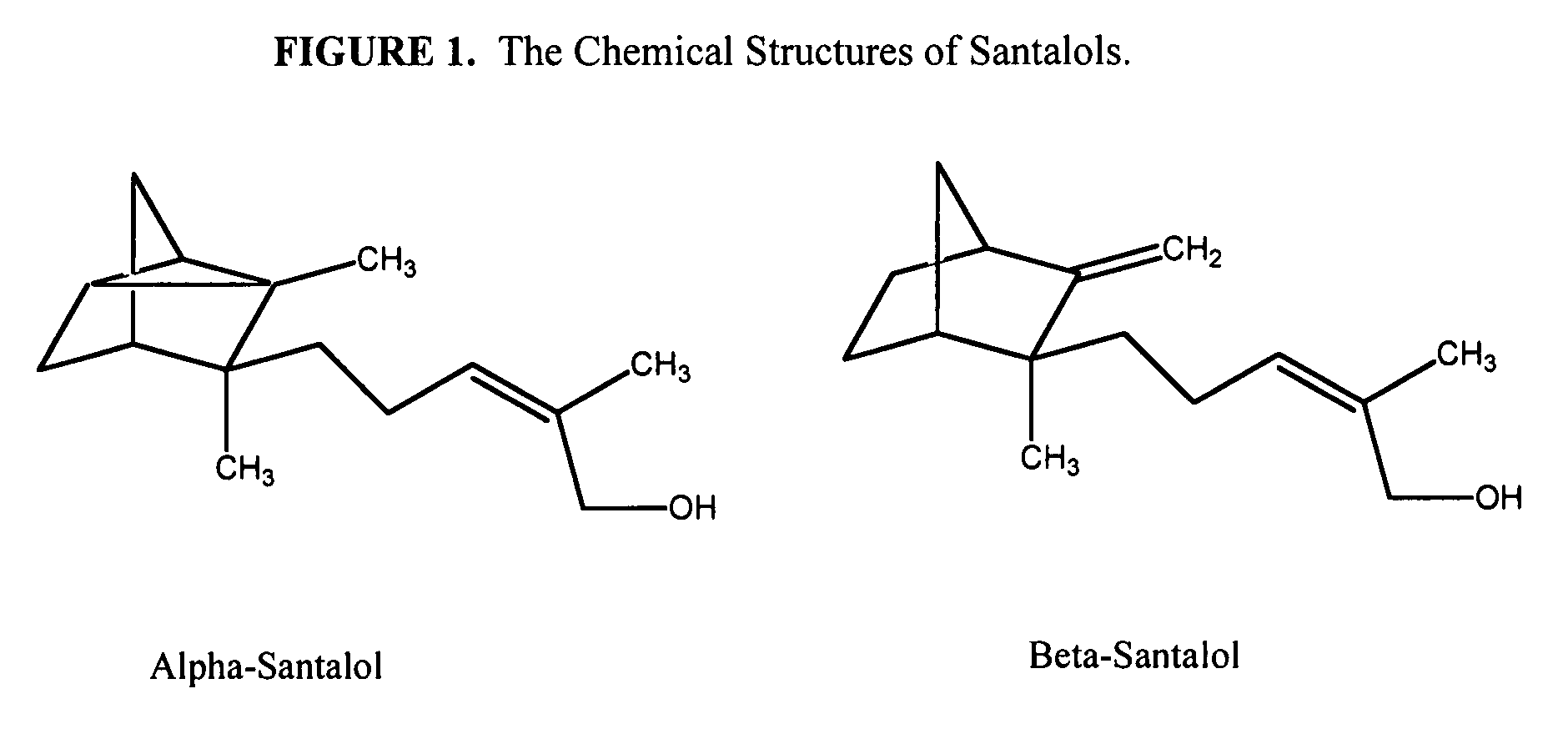Derivatives of sandalwood oil and santalols for treating cold sores and herpes
a technology of sandalwood and santalol, which is applied in the field of herpes treatment, can solve the problems of cold sores or genital herpes, red and inflamed skin around the blisters, etc., and achieve the effect of eliminating sores and reducing the occurrence of skin irritation and rashes
- Summary
- Abstract
- Description
- Claims
- Application Information
AI Technical Summary
Benefits of technology
Problems solved by technology
Method used
Image
Examples
example 1
Preparation of Propionyl Ester of Sandalwood Oil (Formula I, R═C2H5)
[0115]A mixture of 100 ml (˜0.4M of alcohol content) of sandalwood oil (Spectrum Chemicals), 83.5 ml (0.6M) of anhydrous triethylamine (Spectrum Chemicals) and 200 ml of anhydrous dichloromethane was placed into a 1000 ml 2-neck round bottomed flask. The content was covered with aluminum foil to protect it from light exposure. The flask was fitted with a condenser fitted with a moisture trap on the top and a dropwise addition funnel. The flask was cooled to 0 degree centigrade in a dry ice bath and 43.5 ml (0.5M) of propionyl chloride was added from the funnel into the mixture slowly with stirring. After the addition, the mixture was allowed to reach the room temperature and stirred for 3-5 hours. The mixture was transferred into a separating funnel and washed successively with 2×500 ml of water, 2×500 ml of dilute hydrochloric acid, 2×500 ml 10% sodium carbonate solution and 3×500 ml of type I water. The organic la...
example 2
Preparation of Propionyl Ester of Santalol (Formula I, R═C2H5)
[0116]Santalol was prepared by fractional distillation of sandalwood oil (Spectrum Chemicals) under vacuum as described in the literature. A mixture of 100 ml (˜0.375M) of santalol, 83.5 ml (0.6M) of anhydrous triethylamine (Spectrum Chemicals) and 200 ml of anhydrous dichloromethane was placed into a 1000 ml 2-neck round bottomed flask. The content was covered with aluminum foil to protect it from light exposure. The flask was fitted with a condenser fitted with a moisture trap on the top and a dropwise addition funnel. The flask was cooled to 0 degree centigrade in a dry ice bath and 43.5 ml (0.5M) of propionyl chloride was added from the funnel into the mixture slowly with stirring. After the addition, the mixture was allowed to reach the room temperature and stirred for 3-5 hours. The mixture was transferred into a separating funnel and washed successively with 3×500 ml of water, 2×500 ml of dilute hydrochloric acid, ...
example 3
Preparation of Hexanoyl Ester of Sandalwood Oil (Formula I, R═CH3—(CH2)4)
[0117]The compound was prepared essentially as described in Example 1, using n-hexanoyl instead of propanoyl. The product was recovered as a yellow oil.
PUM
| Property | Measurement | Unit |
|---|---|---|
| time | aaaaa | aaaaa |
| healing time | aaaaa | aaaaa |
| concentration | aaaaa | aaaaa |
Abstract
Description
Claims
Application Information
 Login to View More
Login to View More - R&D
- Intellectual Property
- Life Sciences
- Materials
- Tech Scout
- Unparalleled Data Quality
- Higher Quality Content
- 60% Fewer Hallucinations
Browse by: Latest US Patents, China's latest patents, Technical Efficacy Thesaurus, Application Domain, Technology Topic, Popular Technical Reports.
© 2025 PatSnap. All rights reserved.Legal|Privacy policy|Modern Slavery Act Transparency Statement|Sitemap|About US| Contact US: help@patsnap.com

